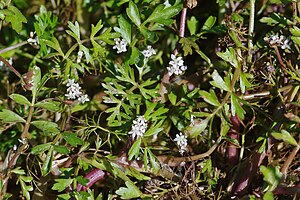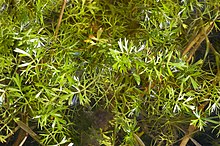Flooding celery
| Flooding celery | ||||||||||||
|---|---|---|---|---|---|---|---|---|---|---|---|---|

Flooding Celery ( Helosciadium inundatum ) |
||||||||||||
| Systematics | ||||||||||||
|
||||||||||||
| Scientific name | ||||||||||||
| Helosciadium inundatum | ||||||||||||
| ( L. ) WDJKoch |
The or the flooding celery ( Helosciadium inundatum ), also known as submerged Scheiberich , is a species of the genus Helosciadium within the umbelliferae family (Apiaceae). The distribution of this sub- aquatic or amphibious plant is largely limited to the Atlantic-sub-Atlantic climatic region of Western Europe .
description
Vegetative characteristics
Flooding celery grows as a deciduous, perennial herbaceous plant and reaches heights of 15 to 60 centimeters. Their sometimes reddish overflowing stems grow prostrate or flooding in the water.
There is heterophyllia . On the one hand, they have hair-thin, two- to triple-pinnate diving leaves and, on the other hand, simply pinnate "air leaves". The latter are located in the upper section of the shoot and consist of wedge-shaped to diamond-shaped, mostly three-lobed partial leaves (for terms of leaf structure, compare: leaf ).
Generative characteristics
The flowering time is especially in June and July. The double-gold inflorescences , which seem to be arranged opposite to the leaf, are relatively small, very inconspicuous and only have two to four rays. A shell is missing . Three to six-fold shells are always present.
The whitish petals are only 0.5 millimeters long.
The fruits are egg-shaped with a length of 2.5 to 3 millimeters.
The number of chromosomes is 2n = 22.
ecology
Flooding Celery is a helomorphic hemicryptophyte and hydrophyte .
Occurrence
The distribution area of the flooding celery is concentrated in the Atlantic, i.e. winter mild humid areas in western Europe, namely in the west-central European lowlands and on the British Isles. It stretches from Ireland, Scotland, Denmark and southern Sweden in the north through Germany, Benelux and France to Italy, the Iberian Peninsula and the edge of north-west Africa in the south. In Germany, the north-west German lowlands (especially Lower Saxony west of the Weser , Schleswig-Holstein ) are populated. The eastern limit of distribution is marked by disjoint occurrences in Western Pomerania , Wendland and Altmark , in Drömling and in Lausitz , among others .
Flooding celery prefers shallow, oligo- to mesotrophic, i.e. nutrient-poor waters with humus-peaty (boggy) mud or sand bottoms . These can be, for example, heather ponds , pasture ponds , waterlogged dune valleys on the North Sea and Baltic Sea islands, sand pit waters or slowly flowing ditches. There, the flood celery grows in strandling societies ( plant-sociological class Littorelletea uniflorae), where it is referred to as "Apium inundatum society" or as "Littorello-Apietum inundati" within the association Hydrocotylo-Baldellion ( hedgehog -hose societies ). This species is also said to be found in poorer species of pelvic herb communities . The locations are often characterized by a certain seasonal alternation of high and low water or drying phases.
Hazard and protection
Flooding celery is a weakly competitive plant species whose habitats have dwindled significantly over the course of the 20th century due to nutrient inputs, pollution, management measures and direct destruction. On the German Red List , the flooding celery was classified as "highly endangered" in 1996. In many places this species has already been lost. In terms of the Nature Conservation Act , it is regarded as "specially protected".
Taxonomy
It was first published in 1753 under the name ( Basionym ) Sison inundatum by Carl von Linné . The new combination to Helosciadium inundatum (L.) WDJ Koch was published in 1824 by Wilhelm Daniel Joseph Koch . Another synonym for Helosciadium inundatum (L.) WDJ Koch is Apium inundatum (L.) Rchb. f. under which this species can often be found in literature and databases.
literature
- AC Ronse, ZA Popper, JC Preston, MF Watson: Taxonomic revision of European Apium L. sl: Helosciadium WDJKoch restored. In: Plant Systematics and Evolution , Volume 287 (1-2), 2010, pp. 1-17.
- Heinz Ellenberg : Pointer values of the vascular plants of Central Europe. (= Scripta Geobotanica, Volume IX), 2nd edition, Verlag Erich Goltze KG, Göttingen 1979, ISBN 3-88452-518-2 .
- Eckhard Garve: Atlas of the endangered fern and flowering plants in Lower Saxony and Bremen. (= Nature Conservation Landscape Maintenance Lower Saxony, Volume 30), 1994. ISBN 3-922321-68-2 .
- Heinz-Dieter Krausch : color atlas water and bank plants. Ulmer-Verlag, Stuttgart 1996, ISBN 3-8001-3352-0 .
- Richard Pott: The plant communities in Germany. UTB, Ulmer-Verlag, Stuttgart 1992, ISBN 3-8252-8067-5 .
- Henning Haeupler, Thomas Muer: picture atlas of the fern and flowering plants of Germany . Ed .: Federal Agency for Nature Conservation (= The fern and flowering plants of Germany . Volume 2 ). Eugen Ulmer, Stuttgart (Hohenheim) 2000, ISBN 3-8001-3364-4 .
- Erich Oberdorfer : Plant-sociological excursion flora . With the collaboration of Theo Müller. 6th, revised and expanded edition. Eugen Ulmer, Stuttgart (Hohenheim) 1990, ISBN 3-8001-3454-3 .
Individual evidence
- ↑ a b Apium inundatum (L.) Rchb.f., Flooding Celery. In: FloraWeb.de.
- ^ Erich Oberdorfer : Plant-sociological excursion flora for Germany and neighboring areas . With the collaboration of Angelika Schwabe and Theo Müller. 8th, heavily revised and expanded edition. Eugen Ulmer, Stuttgart (Hohenheim) 2001, ISBN 3-8001-3131-5 , pp. 708 .
- ^ Ralf Hand, 2011: Apiaceae. : Datasheet Helosciadium inundatum In: Euro + Med Plantbase - the information resource for Euro-Mediterranean plant diversity. Berlin 2011.
- ^ Helosciadium inundatum in the Germplasm Resources Information Network (GRIN), USDA , ARS , National Genetic Resources Program. National Germplasm Resources Laboratory, Beltsville, Maryland. Retrieved January 5, 2015.
Web links
- Profile and distribution map for Bavaria . In: Botanical Information Hub of Bavaria .
- Flooding celery . In: BiolFlor, the database of biological-ecological characteristics of the flora of Germany.
- Datasheet with photos and distribution in the Netherlands. (Dutch)
- Distribution map in the northern hemisphere at linnaeus.nrm.se .
- More pictures from Apium / Helosciadium inundatum at www.biopix.dk .


